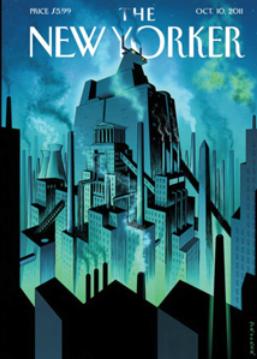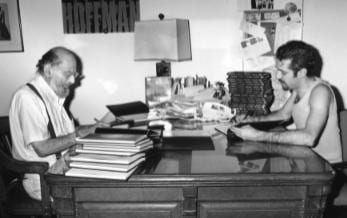
Drooker's latest New Yorker cover.
Eric Drooker remembers seeing Allen Ginsberg from the window of a New York City bus as a teenager.
It is his earliest memory of the late queer poet and activist.
“My mother pointed Ginsberg out to me,” says Drooker, an artist who would later work with Ginsberg. “She explained to me how famous he was.”
Years later, Drooker, then in his 20s, finally had the courage to introduce himself to Ginsberg.
Thus began a friendship and, ultimately, a collaboration that would go on for more than a decade. “At one point I told Allen about the political posters I had created,” Drooker says. “Allen said that he had liked those posters so much he’d ripped them down over the years and had a collection of my work.”
Ginsberg and Drooker eventually collaborated on several book projects, including an illustrated version of Howl, Ginsberg’s book-length poem.
The two also created Illuminated Poems, the last book Ginsberg released before his death in 1997.
Drooker says getting an invitation to work with an icon was a thrill. “Sure, I was a little bit intimidated. It’s always a bit daunting when you’re tackling such a famous poem as Howl. What gave me confidence was that Ginsberg himself let me know that he really dug my work. He was the one who was eager to collaborate. So there was a mutual admiration as well as an artistic harmony between us.”
“Working with Ginsberg was not daunting — it was a pleasure. We lived just two blocks apart, so it was easy. Occasionally, he would give constructive criticism. He didn’t hold back if he didn’t like something, but he generally trusted me.”
When the Oscar-winning filmmaking team of Robert Epstein and Jeffrey Friedman set out to make a feature-length film version of Howl, they approached Drooker to create animated sequences.
“When I showed them some of my artwork, that’s when light bulbs went off over their heads. They thought that perhaps some of the film could be animated. I think Allen would have loved the film, and James Franco’s performance as him.”
While working on Howl, Drooker created one image of a New York City devoid of people and overrun with pollution and corporate greed. In it, the ancient god Moloch — also evoked in Ginsberg’s Howl — lords over the empty city.
Drooker, whose work often appears in The New Yorker, says he offered the illustration to his editors there two years ago.
They refused it then but recently came asking for it to accompany a story in the Oct 10 issue about the Occupy Wall St protest.
“I wanted to depict a city that has become overrun by corporate greed, a city that is no longer for the people,” Drooker says, noting that he thinks Ginsberg would have approved of the Occupy Wall St movement.
“That’s one of the things Allen was famous for . . . urging people to speak their hearts and minds. He felt you should never censor yourself.”
The Deets:
Eric Drooker presents his musical slideshow at Artists Against Apartheid
Fri, Oct 21 at 8pm at Montreal’s La Sala Rosa
4848 St Laurent Blvd

 Why you can trust Xtra
Why you can trust Xtra


